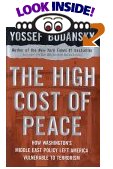|
| Home | About Kashmir Herald | |
Volume 4, No. 6 - December 2004 - January 2005 |
|
| Featured Article |
|
|
|
The Blackest Incident in the History of the
Country VINOD KUMAR Maulana Qureshi, who is also Secretary of the All India Muslim Personal Law Board, is reported to have said that the demolition of the structure at Ayodhya "is the blackest incident in the history of the country" and that "it will not be forgotten till justice is done and the rule of law is established". In response, A Surya Prakash in his article "Wounds on the Hindu Psyche" (Daily Pioneer, December 6, 2004) has given incidents that are far more horrendous than the demolition of Babri structure. Surya Prakash gives the examples of how the temples at Somnath, Mathura and Varanasi -- among countless others -- were demolished and what reverence they held for the Hindus. Has Maulana Qureshi or any other Muslim ever contemplated how the Hindus might have felt -- or continue to feel -- when the icons of their religion were ruthlessly razed to the ground? Let me cite just one more example of "the blackest incidents in the history of the country". The temple at Mathura demolished by Aurangzeb was not the first time it was demolished. A more "spectacular" demolition was recorded by Utbi -- secretary to Mahmud Ghaznavi. Utbi in his Tarikh-e Yamini describes the siege of Mathura in these words: "The Sultan next directed his attacks against the sacred city of Mathura. The city was surrounded by a massive stone wall, in which were two lofty gates opening on to the river. There were magnificent temples all over the city and the largest of them all stood in the center of it. The Sultan was very much struck by its grandeur. In his estimate it cost not less than 100,000,000 red dinars, and even the most skillful of masons must have taken 200 years to complete it. Among the large number of idols in the temples, five were made of pure gold, the eyes of one of them were laid with two rubies worth 100,000 dinars, and another had a sapphire of a very heavy weight. All these five idols yielded gold weighing 98,300 mishkals. The idols made of silver numbered 200ŌĆ”ŌĆ”. He seized all the gold and silver idols and ordered his soldiers to burn all the temples to the ground. The idols in them were deliberately broken into pieces. The city was pillaged for 20 days, and a large number of buildings were reduced to ashes." But Nehru calls Mahmud an admirer of art and architecture because before he plundered and burnt the temple at Mathura down he admired its beauty, and not only that he goes on to call Mahmud "was far more a warrior than a man of faith and like many others conquerors used and exploited the name of religion for his conquests." Surya Prakash wrote how Mahmud turned down offer of large sums of wealth to spare the Somnath temple -- let me not repeat it here. Ferishta gives another similar example of Mahmud's religious convictions. Before his demolition of the temple at Thanesar -- another principal place of worship of the Hindus -- King Anundpal offered him "that the amount of the revenues of that country shall be annually paid to Mahmood and a sum shall also be paid to reimburse him for the expense of the expedition, besides which on his own he will present him with fifty elephants and jewels to a considerable amount." As in the case of the offer at Somnath, Mahmud turned the offer down saying, as Ferishta writes: "The religion of the faithful inculcates the following tenet: 'That in proportion as the tenets of the Prophet are diffused, and his followers exert themselves in subversion of idolatry, so shall be their reward in heaven;' that, therefore, it behoved him, with the assistance of God, to root out the worship of idols from the face of all India. How then should he spare Thanesar?" Evidently Mahmud not interested just in wealth, he had a more important duty to perform. In contrast, the Hindus offered to relocate the Babri masjid to another location at their expense. They were not interested in demolition of the structure just in the site it stood upon. But I have yet to hear any Muslim calling any of the destruction of thousands of Hindu temples by Muslim invaders and rulers from Kasim to Aurangzeb "the blackest incident in the history of the country". Many contend that the Muslims destroyed the Hindu temples for the wealth that the Hindus had accumulated in them. This does not stand even the basic test of logic. While we can understand human greed but we fail to understand why one interested only in plunder would go to disfigure the stone idols and break them in pieces -- how does this enrich the one interested in wealth alone? We can, for the sake of argument, accept than in fury of war one destroyed the stone idols but again why would one just interested in plunder of wealth ship the broken pieces of idols all the way to Ghazna to be kept in front of the main mosque so that the faithful can tread upon them as they enter. This only one who is interested in destroying the idolatry would do. The true nature of Muslim rule in India was captured by Will Durant in his History of Civilization. Describing the rule of Aurangzeb, he wrote: ŌĆ£Aurangzeb cared for nothing for art, destroyed its ŌĆśheathenŌĆÖ monuments with coarse bigotry, and fought, through a reign of half a century, to eradicate from India almost all religions but his own. He issued orders to the principal governors, and to his other subordinates, to raze to the ground all the temples of either Hindus or Christians, to smash every idol, and to close every Hindu school. In one year (1679 ŌĆō 80) sixty-six temples were broken to pieces in Amber alone, sixty-three at Chitor, one hundred and twenty-three at Udaipur; and over the site of a Benares temple especially sacred to the Hindus he built, in deliberate insult, a Mohammedan mosque. He forbade all public worship of the Hindu faith, and laid upon every unconverted Hindu a heavy capitation tax. As a result of his fanaticism, thousands of temples which had represented the art of India through a millennium were laid in ruins. We can never know, from looking at India today, what grandeur and beauty she once possessed.ŌĆØ Aurangzeb, like Mahmud, is an important figure in Indian History. He was, again like Mahmud, one of the most devout Muslims to rule India. He is reported to have memorized the entire Koran and regarded by the Muslims as Alamgir and "Living pir". The Muslim invasions and rule of India is full of so many "blackest incidents in the history of the country" that is difficult to recount. But what our Muslim brothers can see is only the Babri structure. Another anniversary of "the blackest day in the history of the land" has come and gone. Given the sad history of India and the events leading to the demolition of the Babri structure, is it not about time to give up the rhetoric and come to the terms with reality. Muslims should read the history of Muslim invasions and rule as written by the contemporary Muslim historians and ask if what the Muslims did to the Hindus was done to them by the Hindus, how would they have felt? |
 |
 |
 |
|
|
Archives
| Privacy Policy |
Copyrights
|
Contact
Us | |
||